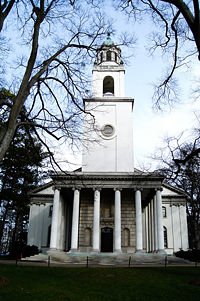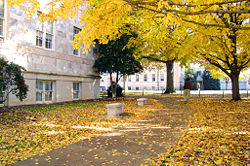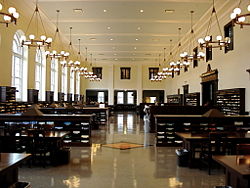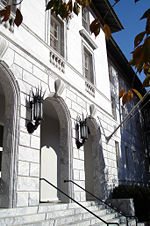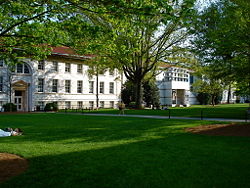Emory University
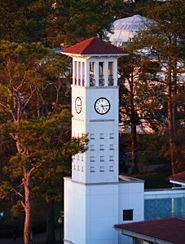
| |
| Motto | Cor prudentis possidebit scientiam (The wise heart seeks knowledge, [[[Book of Proverbs|Proverbs]] 18:15]) |
|---|---|
| Established | 1836[1] |
| Type | Private |
| Location | metro Atlanta, Georgia USA |
| Website | http://www.emory.edu |
Emory University is a private university located in the metropolitan area of the city of Atlanta and in western unincorporated DeKalb County, Georgia, United States. Founded in 1836 and named after John Emory, a popular bishop of the Georgia Methodist Conference, the university consists of nine academic divisions including schools of arts and sciences, theology, business, law, medicine, public health, and nursing.
Mission and Reputation
Stated on the school's web site, the official mission statement of Emory University is: "To create, preserve, teach, and apply knowledge in the service of humanity."[2] The statement goes on to say that Emory strives to achieve this mission by keeping its focus of teaching and research in the core disciplines it has focused on since its founding.[3] While no longer officially affiliated with the Methodist Church, Emory does state that "the University has derived from this heritage the conviction that education can be a strong moral force in both society and the lives of its individual members."[4]
Emory is generally considered a shortlist member of the so-called "Southern Ivy League" and consistently ranks among the top universities in the United States. In 2008 the school ranked 18th among national universities according to U.S. News & World Report[5]. However, it was not until recently that Emory started to have a well-established name recognition across the U.S. While always known for excellence in the regional South, its enrollment of students from other regions remained low until the beginning of the 21st century when it started to actively market itself beyond the South by more active recruitment in other parts of the United States and increased interest and active engagement in national and worldwide issues.[6]
History
On December 10 1836, the Georgia General Assembly granted the Georgia Methodist Conference a charter to establish a college to be named for John Emory, a popular bishop who had presided at the 1834 conference but was killed in 1835 from a carriage accident. In 1837, at its first meeting, the Board of Trustees accepted land belonging to and to establish both a "contemplated college" and a proposed new town of Oxford, Georgia. By 1838, Emory College began admitting students.[7] For the duration of the nineteenth century, Emory College remained a small institution which offered students both a classical curriculum and professional training. Its students studied four years of Greek, Latin, and mathematics and devoted three years to the English Bible and the sciences of geography, astronomy, and chemistry. In 1875, the first laboratory-based studies for students commenced, alongside a rise of activity by the college's debating societies. Such debates included the justifiability of war, women's suffrage, the morality of slavery, and prohibition.
Emory College was closed briefly during the American Civil War. In the autumn of 1861, academic activity almost completely ceased when many of the students left to fight in the conflict. During the war, the college's buildings saw duty both as a Confederate hospital and Union headquarters. The school's library and other archives were destroyed. It was not until the summer of 1865 that the campus was able to fully return to its academic functions. By that time the campus was largely in shambles and the college's small endowment was depleted.[7]
In the years following the Civil War, Emory, along with the rest of the South, struggled to overcome financial devastation. A key moment came in 1880, when Emory president Atticus G. Haygood preached a Thanksgiving Day sermon declaring that slavery had been evil and urging southerners to cultivate industrial growth. The printed sermon was read by George I. Seney, a New York banker and Methodist, who responded by giving Emory College $5,000 to repay its debts, $50,000 for construction, and $75,000 to establish a new endowment—enormous sums for the time.[7]
Emory remained small and financially limited for the next thirty years. In 1913, Bishop Warren A. Candler, a former Emory College president, persuaded the Methodist Episcopal Church, South to make Emory the nucleus of a new university. The General Conference, eager to establish a Methodist university with a school of theology, decided to charter one university east of the Mississippi River and one to the river's west.[7]
In light of these developments, Emory College was rechartered by DeKalb County on January 25, 1915, as Emory University, which explains both the dates 1836 and 1915 sometimes featured on the school's seal. Henry Hornbostel was chosen to design many of the buildings on Emory University's new campus. His designs incorporated local stone and materials in the Georgia marble and red terracotta tile of the structures, which established the institution's unique architectural character. Emory University first opened its theology and law schools on the new campus quadrangle.
In 1919, Emory College moved from Oxford to DeKalb County. Emory University later added graduate, business, medical, public health, nursing, and dental schools. The Emory Dental School has since been closed. Doctoral studies at Emory University were established in 1946, and the school has continued to strengthen its graduate and professional schools since. In 1949, Alben Barkley returned to Emory to receive an honorary LLD degree and give the commencement address, the first Emory event to be televised.
Formerly an all-male school, in 1953 Emory opened its doors to women. Sororities soon followed, and first appeared in 1959. In 1962, in the midst of the American Civil Rights Movement, Emory embraced the initiative to end racial restrictions when it asked the courts to declare portions of the Georgia statutes unconstitutional. Previously, Georgia law denied tax-exempt status to private universities with racially integrated student bodies. The Supreme Court of Georgia ruled in Emory's favor and Emory became officially racially integrated.
Facilities
Emory University's campus is located on 600 rural square acres, and combines many historical and modern buildings and infrastructure. Outside of the normal administrative, dormitory and instructive buildings and halls, the school also has many supplementary structures. The school has 5 libraries, which have seen enormous growth over the 1990s as they increased their holdings to more than 3.1 million volumes. The Special Collections Department of Woodruff Library houses the papers of the British poet Ted Hughes, as well as an extensive Irish collection (William Butler Yeats, Lady Gregory, Maud Gonne, Seamus Heaney, and several contemporary Irish writers). Emory's Special Collections also has concentrations on southern imprints and writers (James Dickey, Alfred Uhry, Mary Hood, and certain papers of Huey Long, for example), and a growing concentration of African American papers, including the work of activist Malcolm X and the Hatch/Billops Collection. Recently, author Salman Rushdie, who has joined the faculty as a Distinguished Writer in Residence, announced he will donate his extensive archive to Woodruff Library.
The Michael C. Carlos Museum houses a permanent collection of some 18,000 objects, including art from Egypt, Greece, Rome, the Near East, the Americas, Asia, Africa, and Oceania as well as European and American prints and drawings ranging from the Middle Ages to the twentieth century. Twenty-nine galleries are maintained for permanent collections, and eight galleries present special exhibitions from all periods.
Programs
The College of Arts and Sciences is the undergraduate institution of Emory University with 66 majors, 53 minors, 17 joint concentrations, and 10 interdepartmental programs leading to a bachelor's degree. It enrolls a little more than 5,000 undergraduate students.[8] The Oxford College of Emory University, located in Oxford, Georgia, enrolls about 700 students. Students at Oxford traditionally complete their first two years of their degree at Oxford and then continue at the College of Arts and Sciences (located on the Atlanta campus) to complete their bachelor's degrees. Because of its size, Oxford College provides low student-teacher ratios in classrooms and a close-knit social community typical of liberal arts colleges.[9]
The Graduate School has degree programs in 26 divisions in which students receive either master's or doctoral degrees. The Candler School of Theology is allied with the United Methodist Church, but enrolls students from many denominations. The Goizueta Business School is often recognized nationally for their MBA program. Emory Law School is currently ranked 22nd by U.S. News and World Report.[10]
The Emory Healthcare System is the largest healthcare provider in Georgia and educates doctors, nurses, and other health professionals. The Emory University School of Medicine enrolls approximately 425 medical students, 1,000 residents and fellows, and 350 allied health students. Collaborating with the nearby Centers for Disease Control and Prevention and other public health organizations, the Rollins School of Public Health has about 800 graduate students.[11]
Colleges and Institutes
Approximately half of its students are enrolled in the undergraduate program and the other half are enrolled in one of Emory University's seven graduate programs. Its nine academic divisions include:
- College of Arts and Sciences
- Oxford College
- Graduate School
- Goizueta Business School
- Emory University School of Law
- Emory University School of Medicine
- Rollins School of Public Health
- Nell Hodgson Woodruff School of Nursing
In addition to its nine schools, the university has numerous institutes and centers devoted to research and community outreach. Some of the more prominent of these include:
- Alzheimer's Disease Research Center
- Center for AIDS Research
- Center for Science Education
- Core Laboratories
- Influenza Pathogenesis & Immunology Research Center
- The Carter Center,
- Yerkes National Primate Research Center
- ScienceNET
Student life
Since the 1960s, Emory's student body has become more regionally and ethnically diverse. According to the school's website, more than 50% of its students are from outside the South, with about 30% from either the mid-Atlantic or northeast United States. Within Emory College's Class of 2012, 43% identify themselves as a member of one or more minority group. Thirty-one percent of the students are Asian, 8.7% African American and 3.5% Hispanic.[12] Since the early 1990s, Emory has also been one of a few Southern universities to include sexual orientation in its non-discrimination policy. The school offers benefits to the domestic partners of gay and lesbian students, staff and faculty. In addition, the campus features centers devoted to female students, Jewish students, international students, multicultural students, and LGBT students.[13]
Fraternities on Emory's campus have existed, officially and unofficially, since 1840. Sororities first came to campus in 1959. For undergraduates, Greek life comprises approximately 30% of the Emory student population, with the Office of Greek Life at Emory University consisting of 12 Fraternities and 13 Sororities.[14] For most students, student life includes involvement in one or more of the 320 campus organizations, which includes a nationally ranked chess team and nationally ranked debate team. More than 100 students work for the University's award-winning student newspaper The Emory Wheel and many work for the school's other student publications, including The Hub, The Spoke, Emory Political Review, the Lullwater Review and the Black Star. Emory also has four secret societies—the D.V.S. Senior Honor Society, the oldest society, founded in 1902; Ducemus; the Order of Ammon; and the Paladin Society. Many students volunteer with Volunteer Emory, Emory's large umbrella community service group.
Emory offers intercollegiate teams for men and women in cross country, swimming, tennis, track and field, basketball, and soccer, as well as golf and baseball for men, and volleyball and softball for women. The teams consistently top the UAA standings and are consistently ranked among the best in NCAA Division III, both regionally and nationally.[15] Club sports, recreation, and intramural sports provide additional competitive opportunities. Club teams include crew, rugby, ultimate frisbee, roller hockey, lacrosse, racquetball, volleyball, sailing, and table tennis, among others. Emory's crew, ultimate frisbee and lacrosse teams have had considerable success and deserve particular note. Many intramural sports are also offered at Emory, ranging from basketball to dodgeball and from wrestling to golf, with flag football and soccer being the most popular. The student body participates heavily in athletics, with eighty percent of students participating in intercollegiate, club, recreation, or intramural sports sometime during their time at Emory. Many students also participate in the Outdoor Emory Organization (OEO)—an organization that sponsors weekend trips of outdoor activities, such as rafting, rock climbing and hiking.[16]
Traditions
Traditions at Emory include Dooley, the "Spirit of Emory" and the unofficial mascot of the university. Dooley is a skeleton and is usually dressed in black. The name "Dooley" was given to the unofficial mascot in 1909. Each year in the spring, during Dooley's Week, Dooley roams Emory's campus flanked by bodyguards ("Dooley guards") and lets students out of class with unscheduled appearances in classrooms. He typically walks slowly with an exaggerated limp. A spokesperson amongst the bodyguards walks with him to deliver his messages as he never speaks himself. His identity is unknown and this is often fodder for campus gossip. He adopts the first name and middle initial of the University's current president. As such, Dooley's current full name is James W. Dooley, after James W. Wagner. Dooley's Week culminates with Dooley's Ball, a grand celebration that takes place in the center of campus on McDonough Field held in celebration of Dooley and Emory University. A sporting match called the Dooley Cup is played between the university administration and the student government association (SGA) each spring as well, and the SGA remains undefeated.[17]
Notable alumni
- Alben W. Barkley - 35th United States Vice President
- John B. Cobb - Process theologian
- James Edward Dickey (class of 1891) - last President of Emory College and first President of Emory University. Later elected a Bishop of the Methodist Episcopal Church, South
- Tinsley Ellis - blues singer
- Lucius Quintus Cincinnatus Lamar (II) - Former United States Supreme Court Justice and Senator from Mississippi
- Gordon Lee (congressman) (class of 1880) - U.S. congressman from Georgia
- Dumas Malone - Pulitzer Prize winning historian, former head of Harvard University Press
- Thomas M. Rivers - Famous virologist, headed the National Science Foundation's search for a polio vaccine
- Robert W. Woodruff - Former President of the Coca-Cola Company (left to work at Coca-Cola after two semesters)
Notes
- ↑ Teodorescu, Daniel (2006-12-01). A Profile of Schools and Academic Resources (PDF). The Office of Institutional Research. Emory University. Retrieved 2007-05-30.
- ↑ (2008) Emory University:Office of the President ["University Mission Statement"] Retrieved October 18, 2008
- ↑ (2008) Emory University:Office of the President ["University Mission Statement"] Retrieved October 18, 2008
- ↑ (2008) Emory University:Office of the President ["University Mission Statement"] Retrieved October 18, 2008
- ↑ (2008) U.S. News & World Report "Best Colleges 2009" Retrieved October 17, 2008
- ↑ Woolhouse, Megan. "Charting Emory's future", Atlanta Business Chronicle. Sept. 10, 2004. [1] Retrieved October 18, 2008
- ↑ 7.0 7.1 7.2 7.3 English, Thomas H. Emory University 1915–1965: A Semicentennial History (Atlanta: Emory University, 1966).
- ↑ (2008) Collegeboard.com "Emory University" Retrieved October 18, 2008
- ↑ (2008) Emory University "Oxford Facts" Retrieved October 18, 2008
- ↑ (2008) U.S. News and World Report "Best Graduate Schools" Retrieved October 18, 2008
- ↑ (2008) Emory University "Emory Healthcare" Retrieved October 18, 2008
- ↑ (2008) Emory University "Class Profile" Retrieved October 18, 2008
- ↑ Pope-Roush, Jordan and Kimberly Moore. Emory University: Off the Record - College Prowler (College Prowler, 2006. ISBN 1427400598)
- ↑ Pope-Roush, Jordan and Kimberly Moore. Emory University: Off the Record - College Prowler (College Prowler, 2006. ISBN 1427400598)
- ↑ (2008) StateUniversity.com "Emory University" Retrieved October 18, 2008
- ↑ (2008) StateUniversity.com "Emory University" Retrieved October 18, 2008
- ↑ (2008) StateUniversity.com "Emory University" Retrieved October 18, 2008
ReferencesISBN links support NWE through referral fees
- "Emory University," in New Georgia Encyclopedia. Retrieved July 1, 2006.
- "Emory University," in Encyclopedia of Southern Culture, ed. C. R. Wilson and William Ferris (Chapel Hill: University of North Carolina Press, 1989).
- English, Thomas H. Emory University 1915–1965: A Semicentennial History. Atlanta: Emory University, 1966.
- Gleason, Jan. "Emory ranked 9th-best national university by U.S. News & World Report magazine" in Emory Report 50, no. 1 (1997).
- Hauk, Gary S. A Legacy of Heart and Mind: Emory since 1836 (Atlanta: Emory University, developed and produced by Bookhouse Group, Inc., 1999).
- Young, James Harvey. "A Brief History of Emory University," in Emory College Catalog 2003–2005 (Atlanta: Emory University Office of University Publications, 2003), 9–15.
External links
| Association of American Universities | |
|---|---|
| Public | Arizona • Buffalo (SUNY) • UC Berkeley • UC Davis • UC Irvine • UCLA • UC San Diego • UC Santa Barbara • Colorado • Florida • Illinois • Indiana • Iowa • Iowa State • Kansas • Maryland • Michigan • Michigan State • Minnesota • Missouri • Nebraska • North Carolina • Ohio State • Oregon • Penn State • Pittsburgh • Purdue • Rutgers • Stony Brook (SUNY) • Texas • Texas A&M • Virginia • Washington • Wisconsin |
| Private | |
| Canadian | McGill • Toronto |
Credits
New World Encyclopedia writers and editors rewrote and completed the Wikipedia article in accordance with New World Encyclopedia standards. This article abides by terms of the Creative Commons CC-by-sa 3.0 License (CC-by-sa), which may be used and disseminated with proper attribution. Credit is due under the terms of this license that can reference both the New World Encyclopedia contributors and the selfless volunteer contributors of the Wikimedia Foundation. To cite this article click here for a list of acceptable citing formats.The history of earlier contributions by wikipedians is accessible to researchers here:
The history of this article since it was imported to New World Encyclopedia:
Note: Some restrictions may apply to use of individual images which are separately licensed.
